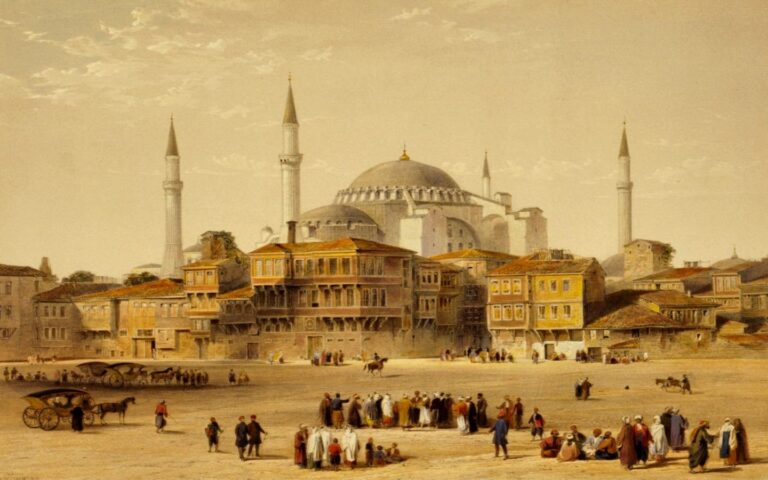
1. Before Islam – Life in Arabia
Time: Before 610 CE
- Arabia before Islam was full of different tribes.
- People mostly believed in many gods (polytheism).
- Mecca was a rich city where people came to trade and to worship at the Kaaba.
- The society had many problems: rich people were very rich, poor people were treated badly, and women had very few rights.
- Poetry and stories were very important in Arab culture.
2. Prophet Muhammad ﷺ – The Beginning of Islam
Time: 570–632 CE
- Prophet Muhammad ﷺ was born in Mecca in 570 CE.
- He was honest and wise. He worked as a trader and married Khadijah.
- At age 40, he received the first message from Allah through Angel Jibreel (Gabriel).
- He began to teach that there is only one God (Allah), and that people should be kind, honest, and just.
Important Events:
- Persecution in Mecca: The leaders of Mecca did not like his message. They tried to stop him and his followers.
- Hijrah (Migration): In 622 CE, Muhammad and his followers moved to Medina. This event is called Hijrah and it marks the start of the Islamic calendar.
- In Medina, the first Muslim community (Ummah) was built.
- There were battles with the people of Mecca (e.g. Badr, Uhud, and the Trench).
- In 630 CE, Muslims peacefully took back Mecca.
- In 632 CE, the Prophet passed away after doing his final pilgrimage (Hajj).
- His message became the base of the religion called Islam.
3. The Four Rightly-Guided Caliphs (Rāshidūn)
Time: 632–661 CE
After the Prophet’s death, four close companions became leaders (Caliphs):
- Abu Bakr – United the Arab tribes.
- Umar ibn al-Khattab – Expanded Islam into Iraq, Persia, and Egypt.
- Uthman ibn Affan – Compiled the Qur’an into one book.
- Ali ibn Abi Talib – Faced civil wars and political fights.
- These leaders ruled fairly and followed Islamic values.
- But problems about who should lead the Muslims caused fighting.
- This led to the split between Sunni and Shia Muslims.
4. Umayyad Caliphate
Time: 661–750 CE
- Muawiyah became the first Umayyad Caliph. The capital was moved to Damascus (in Syria).
- The empire grew fast: into North Africa, Spain, Central Asia.
- Arabic became the main language. Coins, roads, and postal systems were created.
- But the Umayyads favored Arab Muslims, and non-Arabs were treated unequally.
- This caused anger and revolts. In 750 CE, the Umayyads were defeated by a new group—the Abbasids.
5. Abbasid Caliphate
Time: 750–1258 CE
- The Abbasids moved the capital to Baghdad (Iraq).
- Baghdad became a center of knowledge, science, and culture.
- This time is called the Golden Age of Islam.
- Muslims translated books from Greek, Persian, and Indian languages into Arabic.
- Scholars made great progress in:
- Medicine
- Math (algebra)
- Astronomy
- Philosophy
- Literature (e.g. One Thousand and One Nights)
But:
- The empire became too big.
- Local rulers gained power.
- The empire split into smaller parts.
- In 1258, the Mongols attacked Baghdad and ended Abbasid rule.
6. Islamic Rule in Different Parts of the World
After the Abbasids, many Muslim dynasties ruled in different regions:
A. Spain (Al-Andalus)
- Muslims ruled Spain from 711–1492.
- It was a center for science, art, and culture.
- Muslims, Christians, and Jews lived together for many years.
- In 1492, Christian rulers took back Spain (the Reconquista).
B. Africa, Persia, Central Asia
- The Fatimids ruled parts of North Africa.
- The Seljuks ruled Persia and parts of Anatolia (Turkey).
- The Ayyubids were led by Salahuddin (Saladin), who took back Jerusalem during the Crusades.
C. India and Southeast Asia
- Islam entered India through trade and conquest.
- The Delhi Sultanate (1206–1526) was one of the first Muslim governments in India.
- Later, the Mughal Empire ruled most of India (1526–1857).
- In Southeast Asia (Malaysia, Indonesia), Islam spread peacefully through trade and Sufi teachers.
7. The Great Muslim Empires – “Gunpowder Empires”
Time: 1300s–1800s
A. Ottoman Empire
- Began in Turkey in the late 1200s.
- Took over Constantinople in 1453 (renamed it Istanbul).
- Ruled parts of Europe, the Middle East, and North Africa.
- Powerful army and government, rich culture, and architecture.
B. Safavid Empire (Persia/Iran)
- Made Shi’a Islam the official religion.
- Ruled Iran and parts of Central Asia.
C. Mughal Empire (India)
- Famous rulers like Akbar, Shah Jahan (who built the Taj Mahal).
- Blended Indian and Islamic cultures.
- Faced decline in the 1700s with British arrival.
8. Islamic Culture and Knowledge
- Sufism (Islamic mysticism) grew during this time. Sufis focused on love, peace, and closeness to God.
- Many schools of Islamic law were developed:
- Sunni: Hanafi, Maliki, Shafi’i, Hanbali
- Shia: Ja’fari, others
- Muslims built great libraries and schools (madrasas).
- Scholars studied and wrote books on the Qur’an (tafsir), Hadith, history, science, and more.
9. European Colonialism and Muslim Response
Time: 1700s–1900s
- Muslim lands became weak, and European powers (Britain, France, others) took control of many areas.
- Examples:
- India: British ruled after 1857
- Egypt, Algeria, Tunisia: French rule
- Indonesia: Dutch rule
Muslim Response:
- Some wanted to return to Islamic roots (e.g. Wahhabism in Arabia).
- Others tried to modernize Islam and learn from Europe.
- Thinkers like Jamaluddin Afghani, Muhammad Abduh, and Sir Syed Ahmad Khan tried to reform Muslim societies.
10. Modern Islamic World – 20th Century to Today
A. After World War I
- The Ottoman Empire ended after WWI.
- New countries were created: Iraq, Syria, Jordan, Saudi Arabia, etc.
- Some leaders wanted secular (non-religious) governments.
- Others wanted Islamic laws and values in government.
B. Rise of Movements
- Groups like Muslim Brotherhood in Egypt and Jamaat-e-Islami in South Asia were formed.
- These groups wanted to bring back Islamic values in politics and society.
C. Challenges
- Some extreme groups misused Islam to justify violence.
- Many Muslims around the world have worked to promote peace, education, and dialogue with other religions.
11. Islam Today
- Islam is the second-largest religion in the world.
- Over 1.9 billion Muslims live across every continent.
- Large Muslim populations in:
- Indonesia
- Pakistan
- India
- Bangladesh
- Middle East
- Africa
- Europe and North America
